Kuccps registration 2024 – The KUCCPS Portal
The Kenya Universities and Colleges Central Placement Service (KUCCPS) co-ordinates the placement of government sponsored students to universities and colleges in Kenya.
School principals usually select courses for the students during the last term in school. Some do not and this should be no cause for alarm.
KUCCPS announces first revision of courses (KUCCPS 1st Revision of Courses) shortly after the release of KCSE results. Usually within a month or two.
After the first revision of courses, students are placed in colleges or universities according to their choices. Those who have not been placed are invited for the second revision of courses that happens a month or two after the first revision.
The list of those who were not placed during the first revision is published and you can find your index number on the list if you need to participate in the second revision (KUCCPS 2nd Revision of Courses.)
You will not be able to see the following details until the portal opens for applications. Wait for that date and follow our daily updates for the news of opening and closing dates.
Step One: Accessing the Website
1. Visit the KUCCPS website on www.kuccps.net
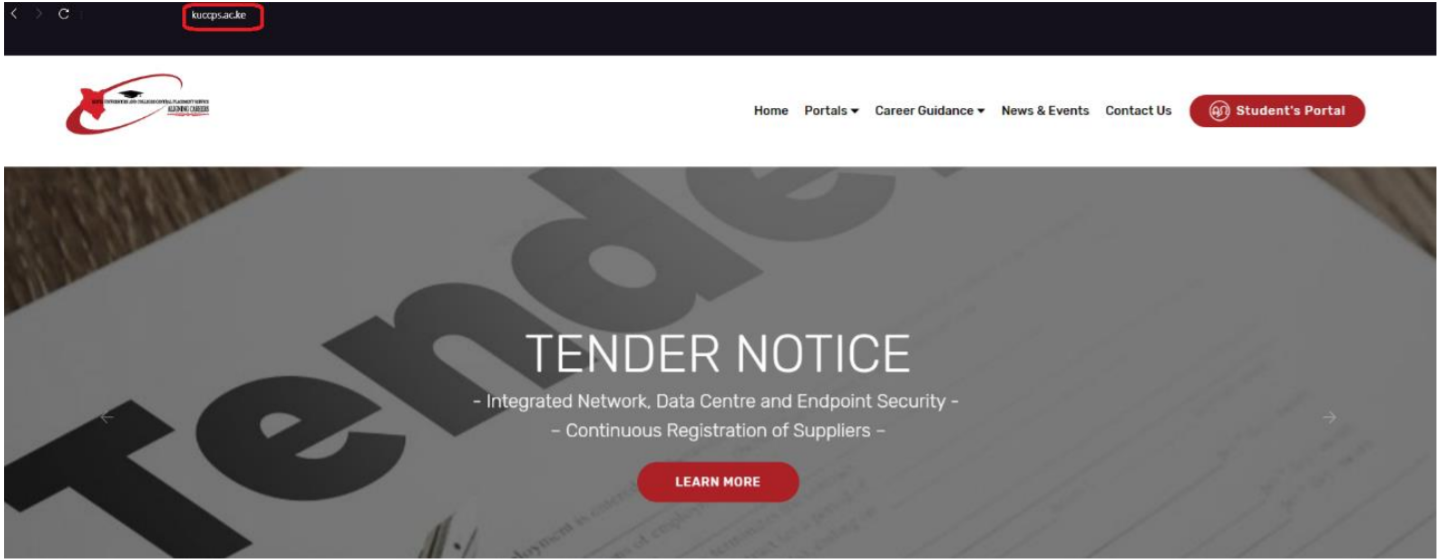
Step Two: Accessing the Student’s Portal
1. Click on the button marked: “Student’s Portal” as shown in the image below.
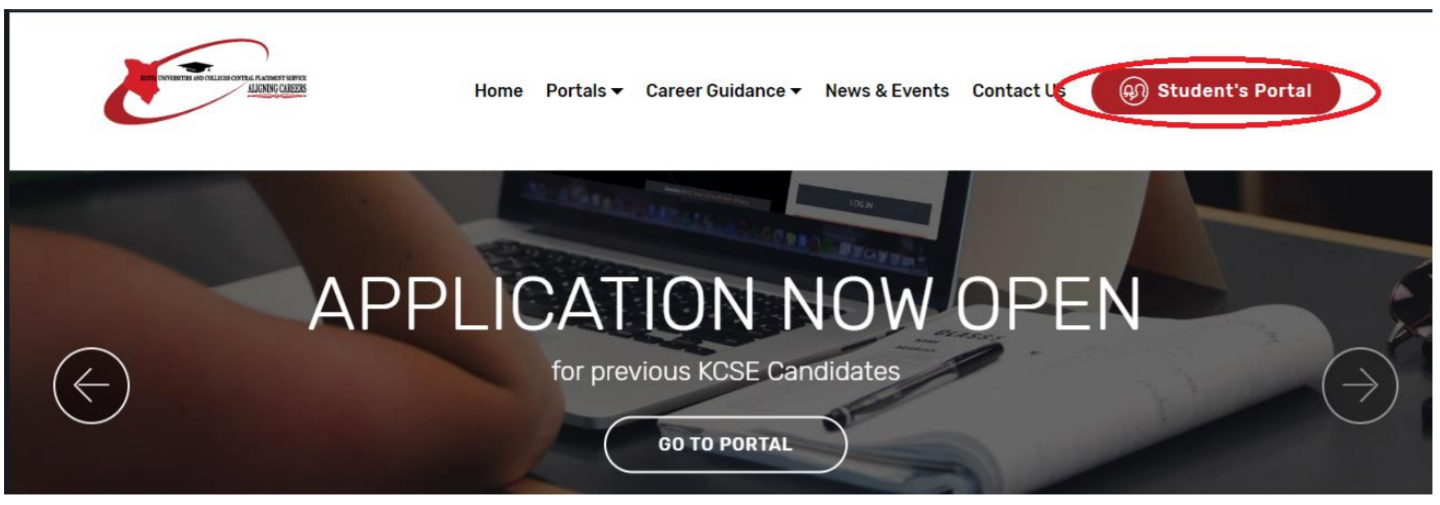
Step Three: Accessing the Login button
1. Click on the button marked: “LOGIN”
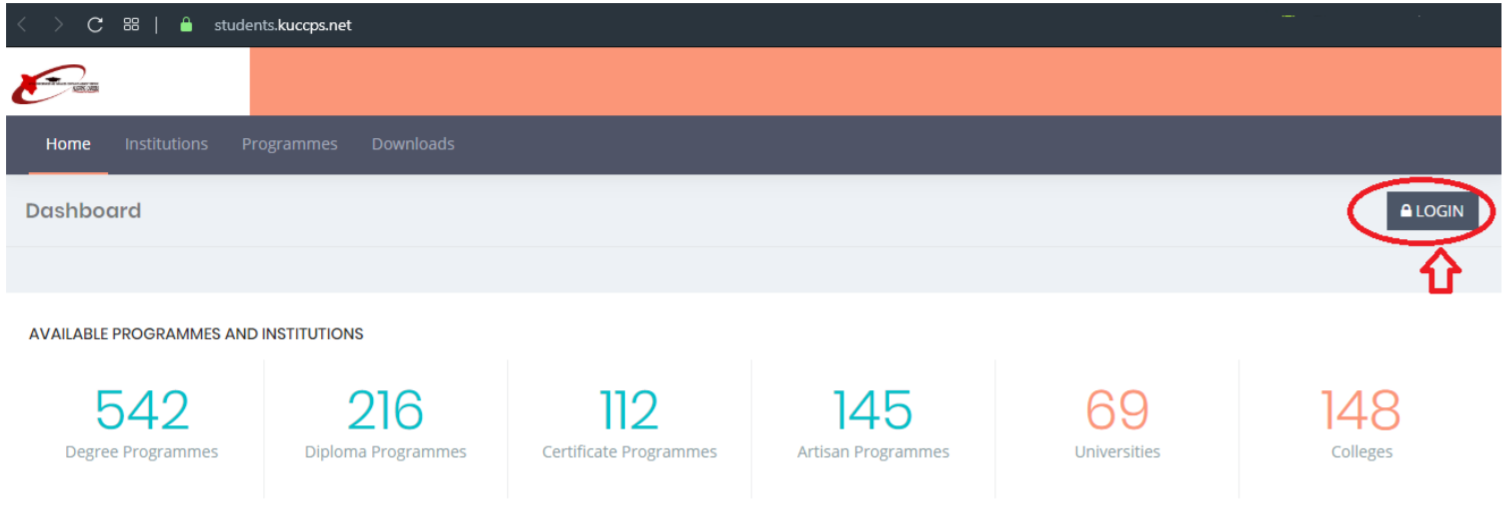
Step Four: Logging in
1. Enter your KCSE Index Number, Year of KCSE and your password (KCPE Index or Birth Certificate Number).
2. Click on the button marked: “LOG IN” as shown below.
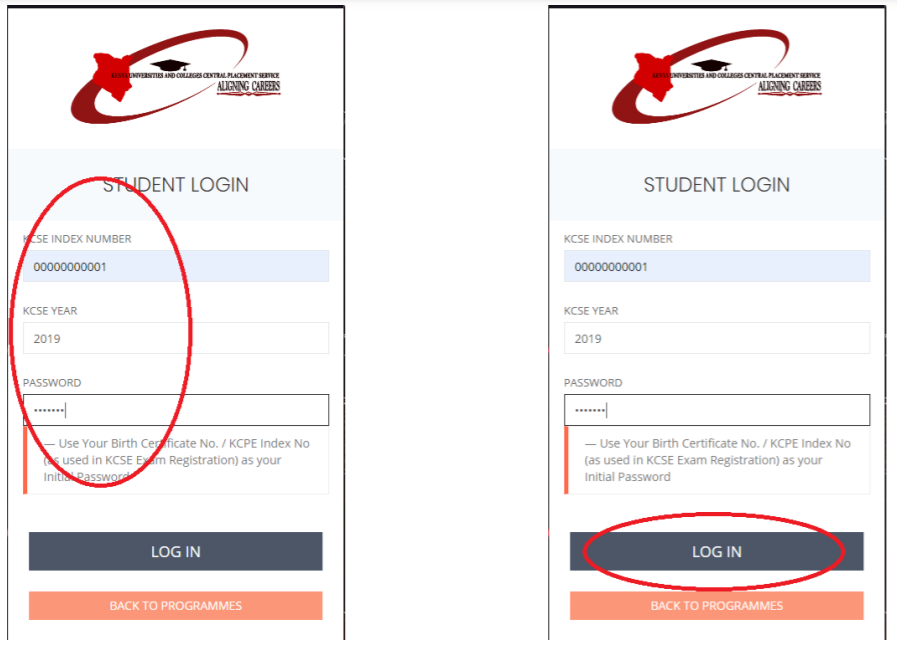
Note
Applicant Eligibility
For a candidate to be eligible to apply for placement, the following conditions will apply:
i. A Kenyan Citizen governed by Chapter Three of the Constitution of Kenya and the Kenya Citizenship Act Cap 170.
ii. Sponsorship will be eligible to all applicants provided that the KCSE Candidates of the year preceding the selection and those who have never benefited before are given priority.
iii. The minimum admission requirement to apply for degree programmes will be C+.
iv. The minimum admission requirement to apply for a diploma will be C-.
v. The minimum admission requirement to apply for a craft certificate will be D.
vi. The minimum admission requirement to apply for an Artisan certificate will be E.
vii. Applications shall be subjected to minimum subjects requirements from regulators and training institutions where applicable.
Step Five: Dashboard
On the dashboard, you will be able to view:
1. A summary of the available institutions and courses.

2. The applicant’s weighted cluster points for the 23 clusters (for Degree-qualified applicants only). The PDF with all the clusters can be found under ‘Downloads’
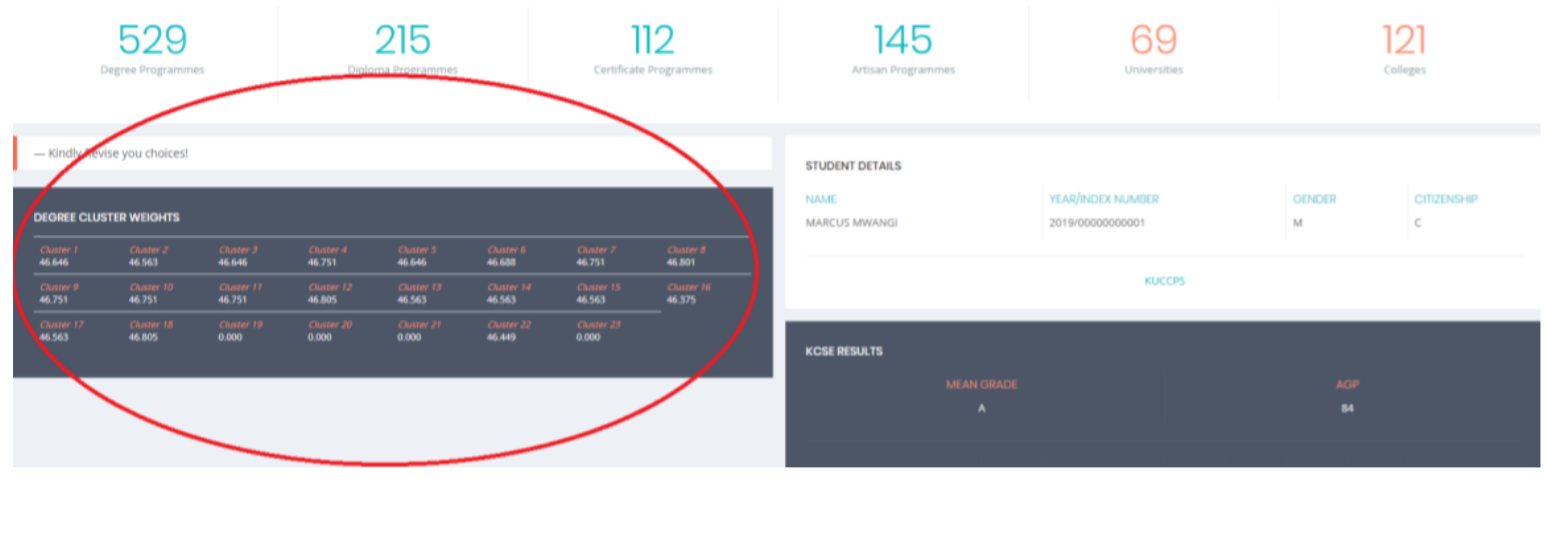
NOTE:
Where the points read ‘0.000’ the candidate did not sit examinations for a subject that is mandatory for courses in a cluster.
3. The applicant’s registration details and performance as received from KNEC.
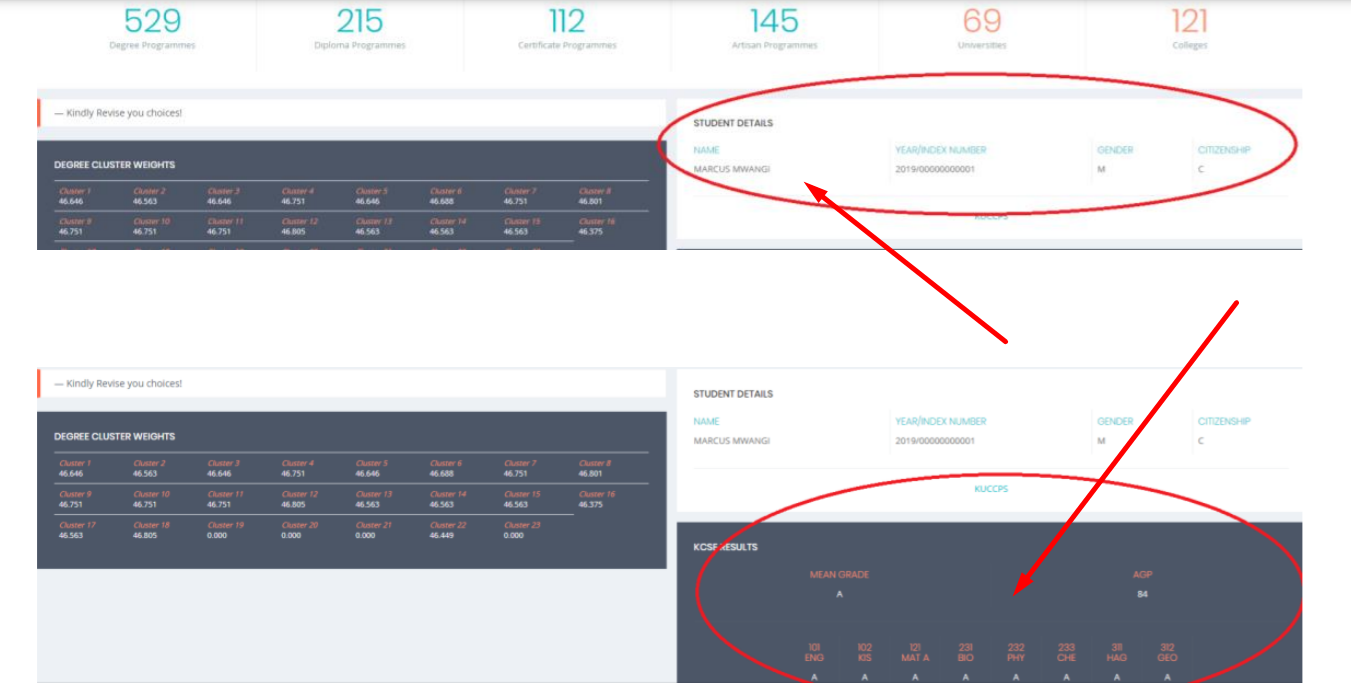
Step Six: Institutions
1. To view the institutions available for application, click on the menu link “Institutions”
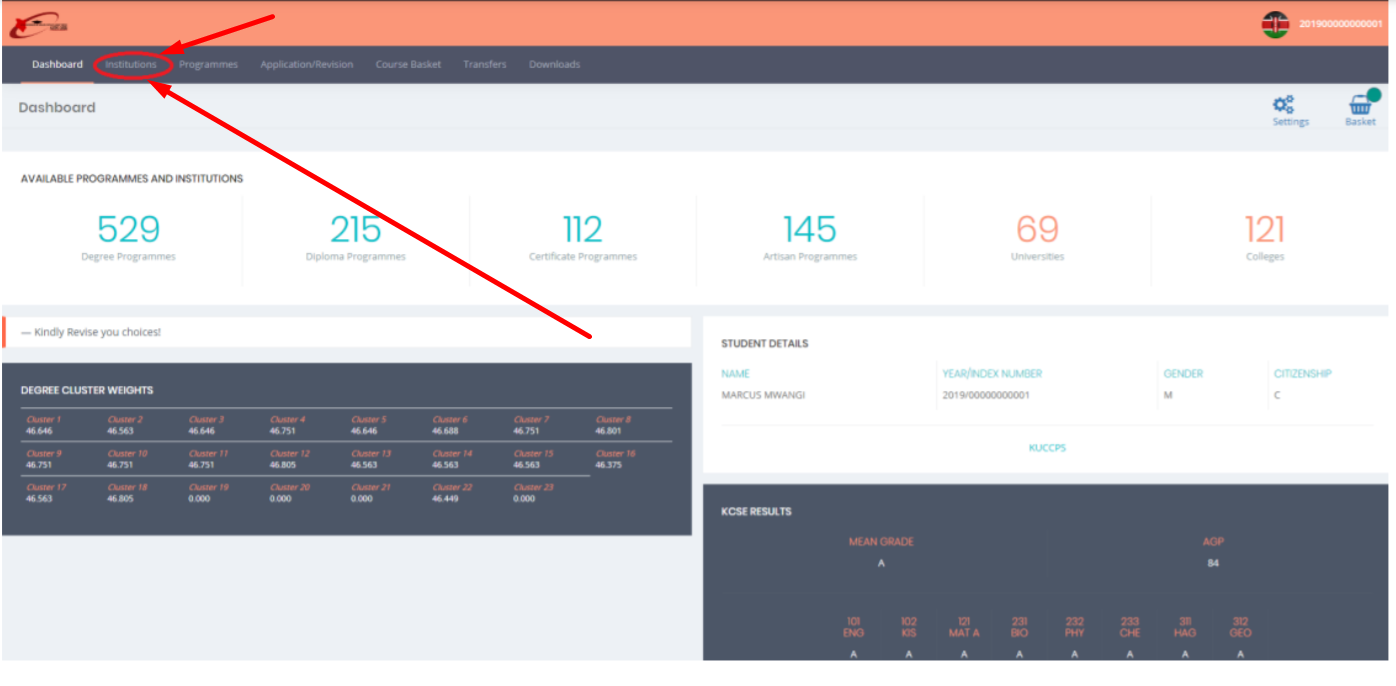
2. A list of all institutions will be displayed as shown:
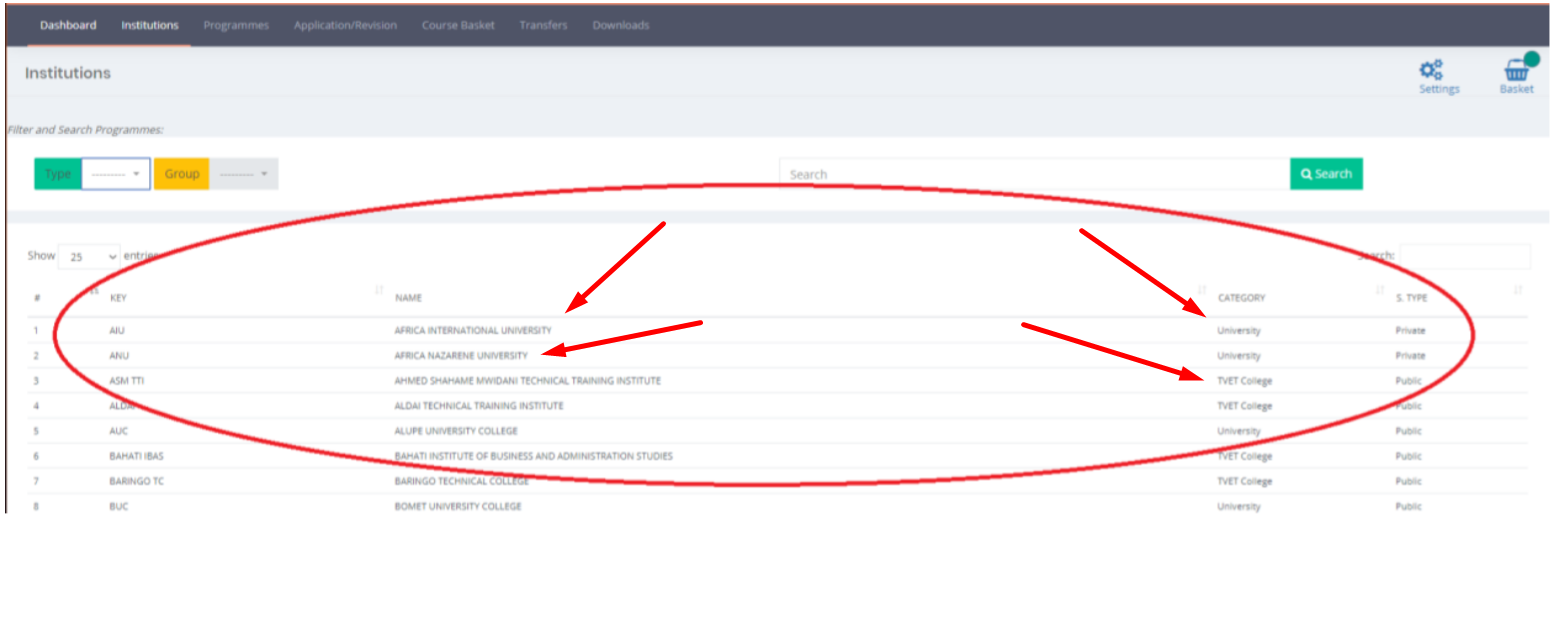
3. Clicking on any of the institutions will display the programmes they have on offer, that is:
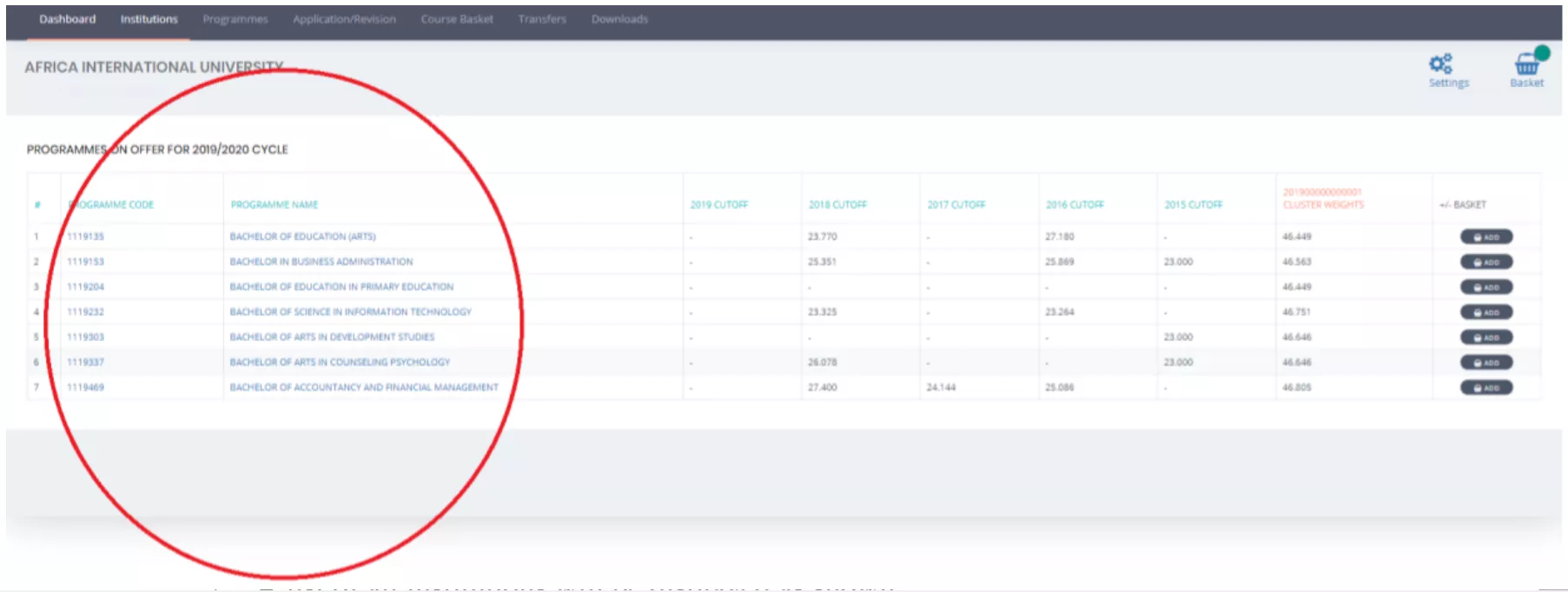
Step Seven: Programmes on Offer
1. To view the programmes on offer for application, click on the menu link “Programmes”

2. All programmes have been grouped into wide fields of interest to assist the applicants choose their most preferred programme.

3. Clicking on any of the fields lists all programmes classified under it e.g. ‘Business (Diploma)’ returns:
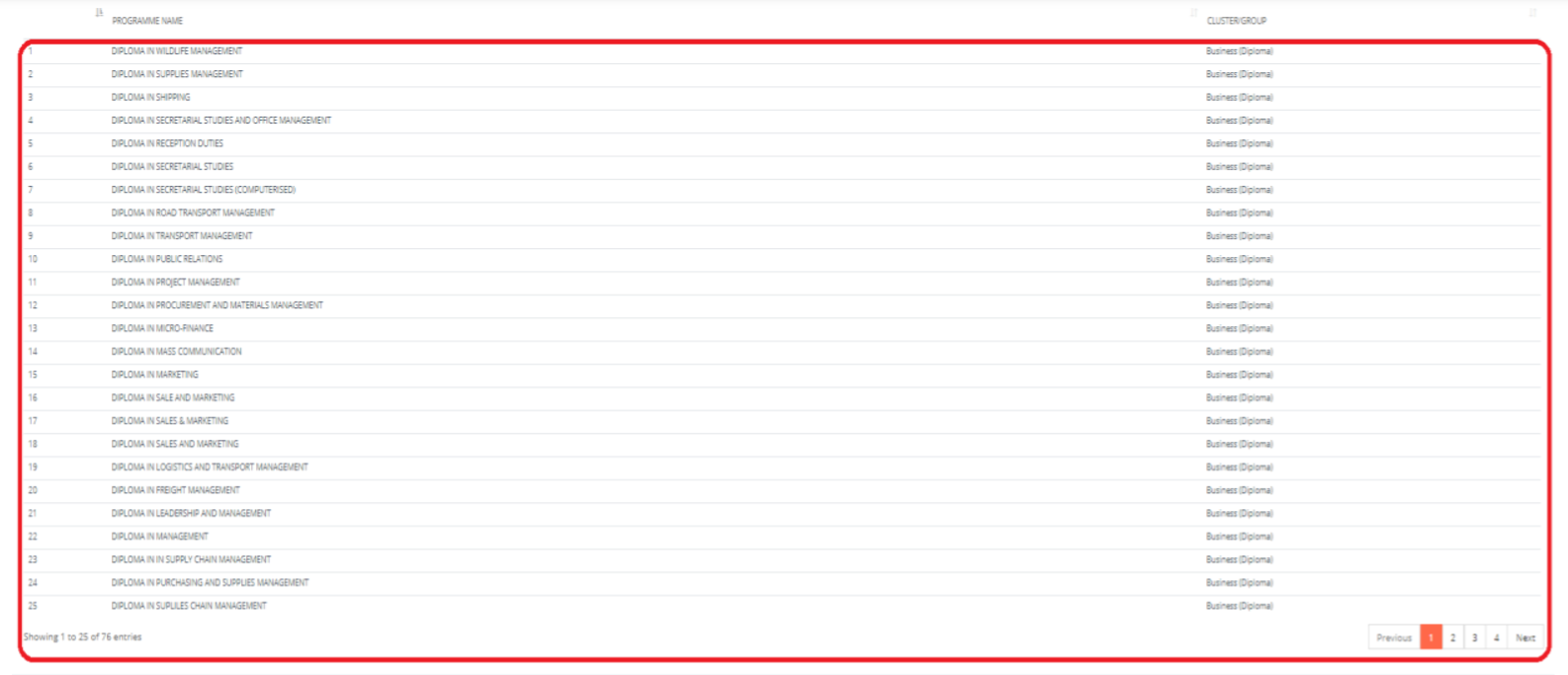
4. A search-bar has been provided to ease the process if the applicant already knows the programme they would like to apply for:

5. The applicant only needs to type part of the title e.g. searching for ‘Civil’ returns:
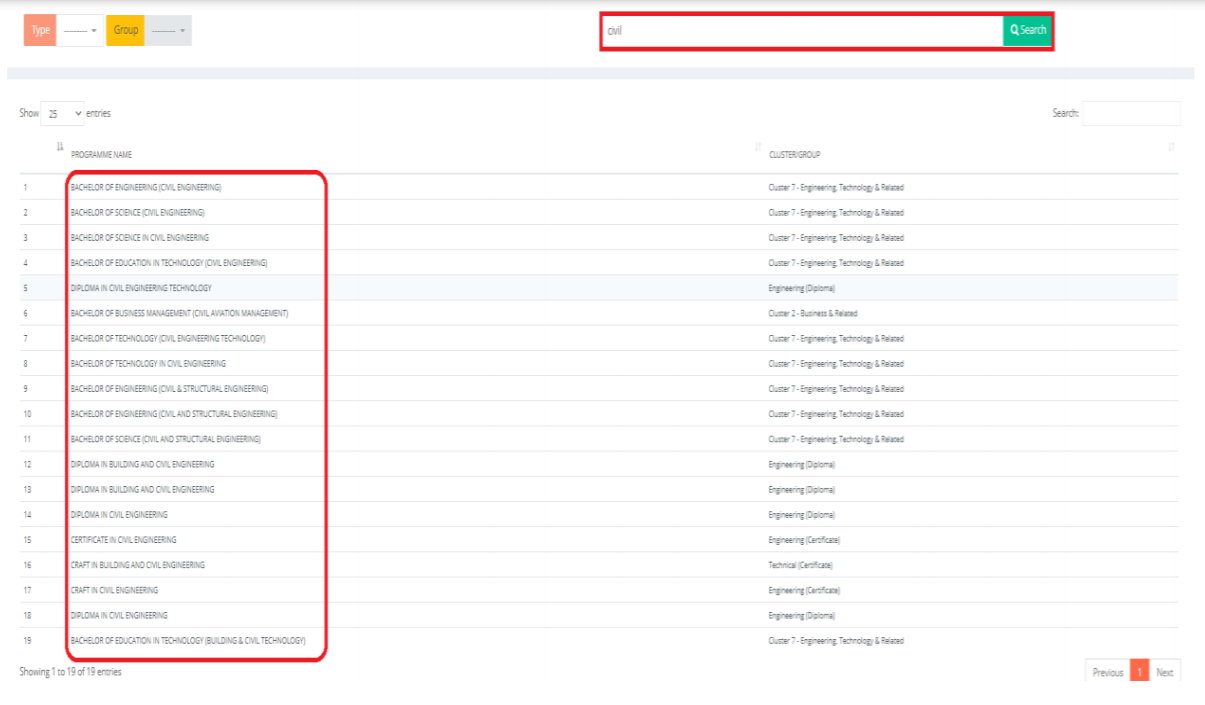
6. Clicking any of the programmes opens a page detailing the programme information.
Notes:
Applicant Choices
Applicant will be expected to make applications by submitting their preferred choices where a valid choice will constitute a programme code, programme name and the institution name.
i. Applicants with an overall grade of C+ and above will be allowed to make a maximum of 6 choices for degree programmes where 1(a), 1(b) and 1(c) must be similar programmes and 4 for diploma programmes.
ii. Applicants with an overall grade of C- and above, will be allowed to make a maximum of 8 choices; 4 for diploma and 4 for craft certificate programmes.
iii. Applicants with an overall grade of D and above, will be allowed to make a maximum of 8 choices; 4 for craft certificate and 4 for artisan certificate programmes.
iv. Applicants with an overall grade below D, will be allowed to make a maximum of 4 choices from artisan certificate programmes.
v. An applicant may choose any programmes for which they qualify provided that no choice is repeated.
Step Eight: Programme Details
1. The programme page displays either:
a. The cluster subjects used to calculate weighted cluster points (for Degree programmes)

Or:
b. The Minimum mean grade (for TVET programmes)
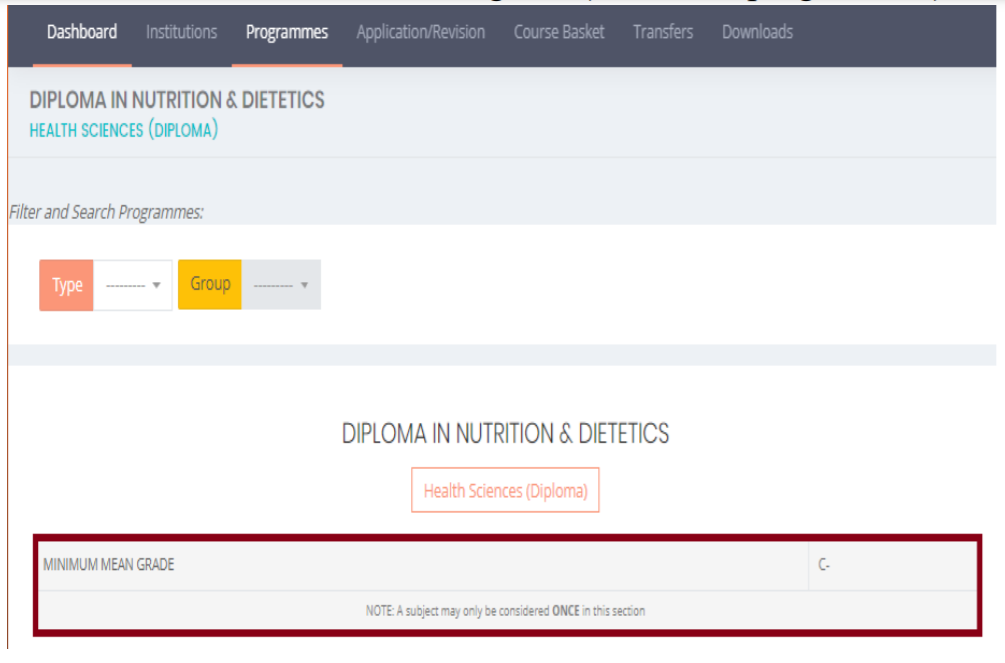
2. The minimum subject requirements (where applicable) are also outlined on this page:
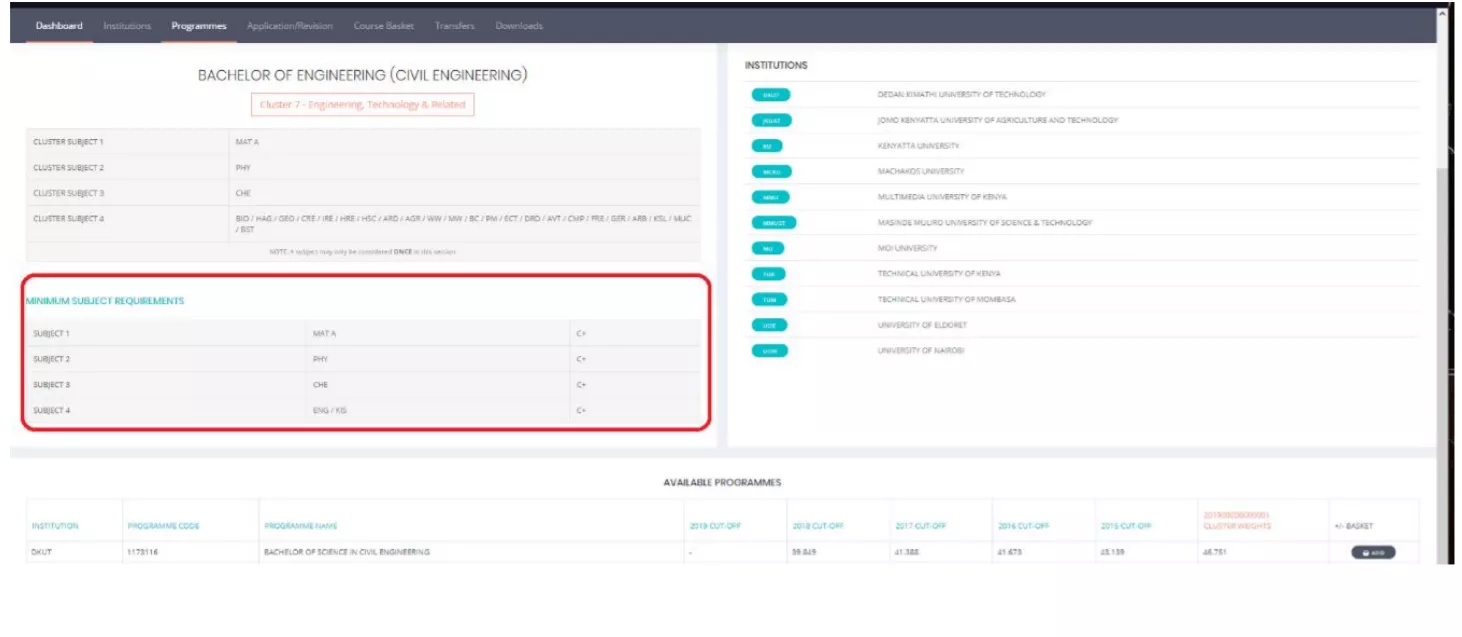
NOTE: To pursue a course you must have:
i. Sat for the subjects listed during their KCSE examination.
ii. Attained the grade listed or higher.
3. All the institutions that offer the programme will be listed at the bottom of the page, along with previous years’ cut-off points.
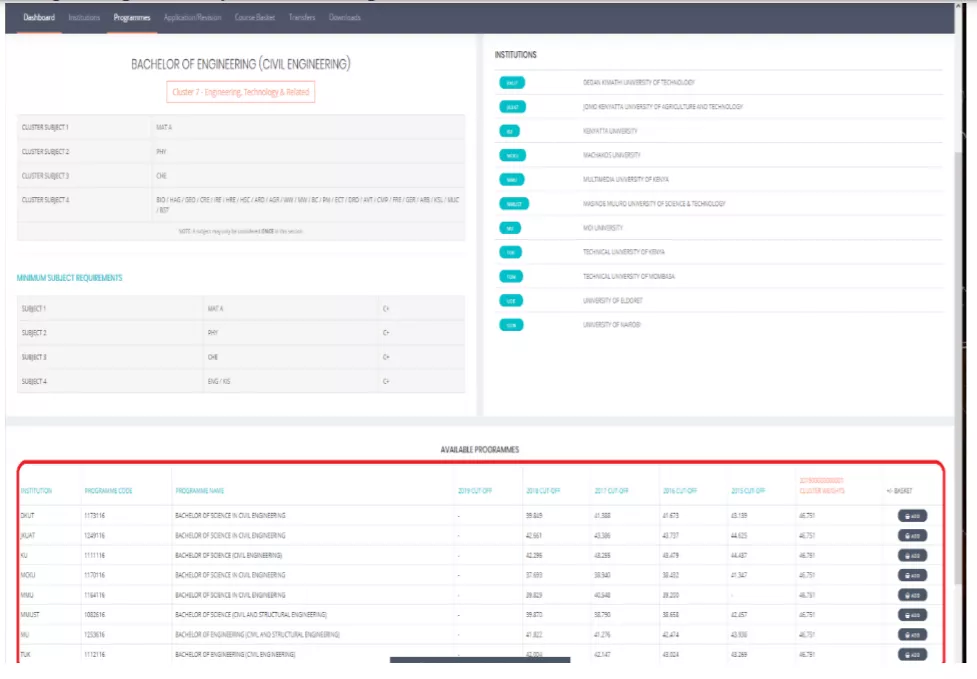
Step Nine: Choosing your Programmes
1. For Degree applicants, the Weighted Cluster Points are already calculated and displayed per programme on the right-most column.
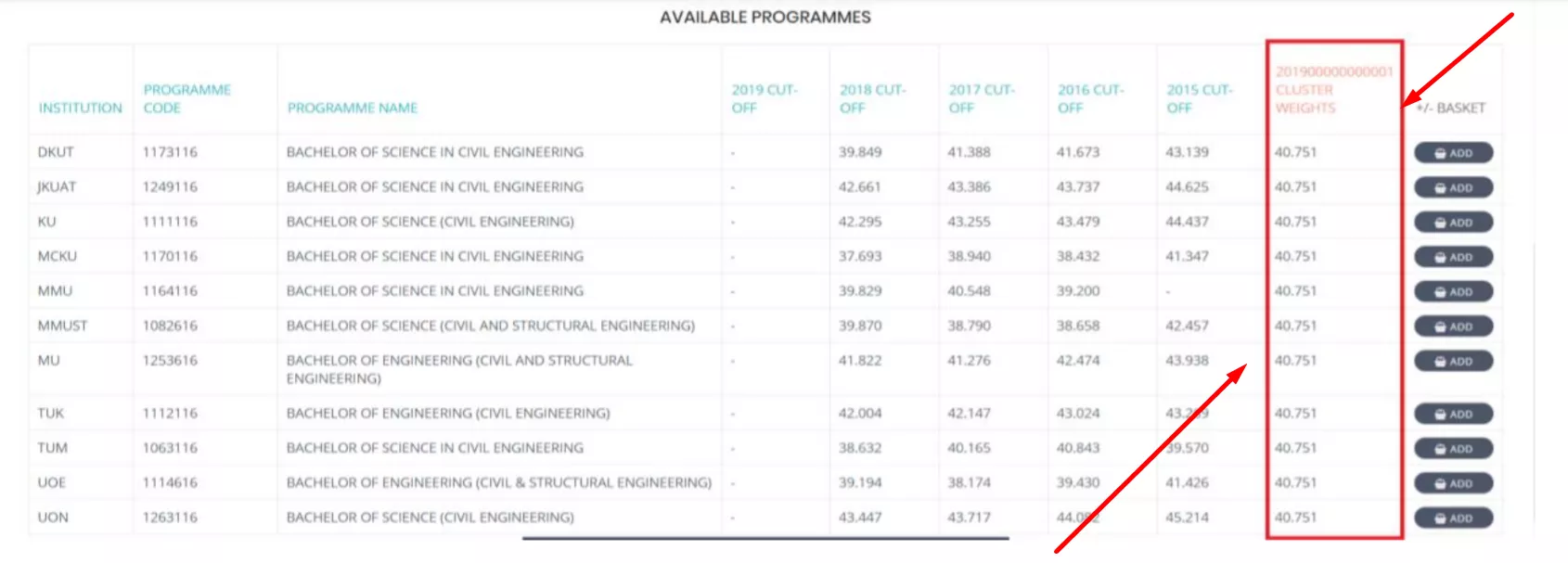
2. The previous cut-off points for each programme are listed per institution to guide degree applicants.
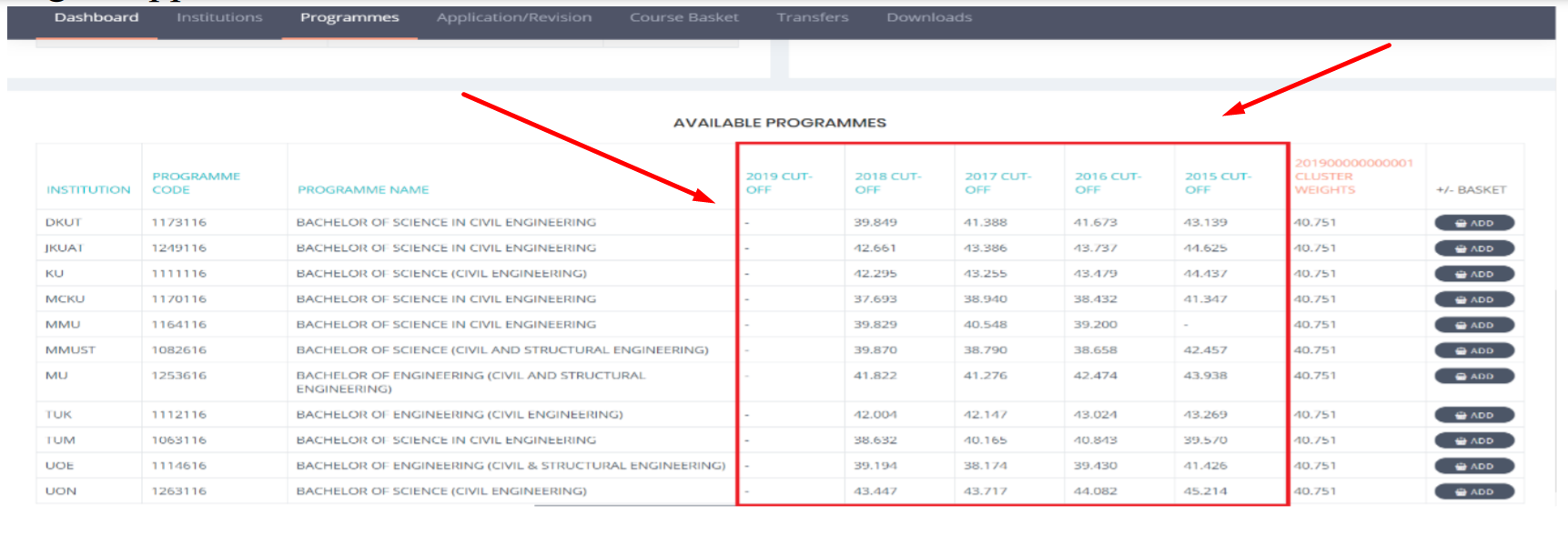
Tip:
Cut-off points for any year are the weighted cluster points for the last competititvely placed applicant. i.e. Suppose the Bachelor of Arts programme at an institution requires only 10 students but 13 applications are received.
The best performing 10 applicants will be picked and the that are 3 left out will be considered for their other choices. However, the weighted points for the last (10th) student will form the cut-off points for the programme at the institution.
NOTE:
i. The cut-off points are not predetermined and will not be available while applications are ongoing.
ii. Cut-off points vary by programme, institution and application year.
iii. Previous years’ cut-off points are provided to guide applicants during the application process.
TVET applicants only use the minimum grade and subject requirements to gauge their qualification to a programme.
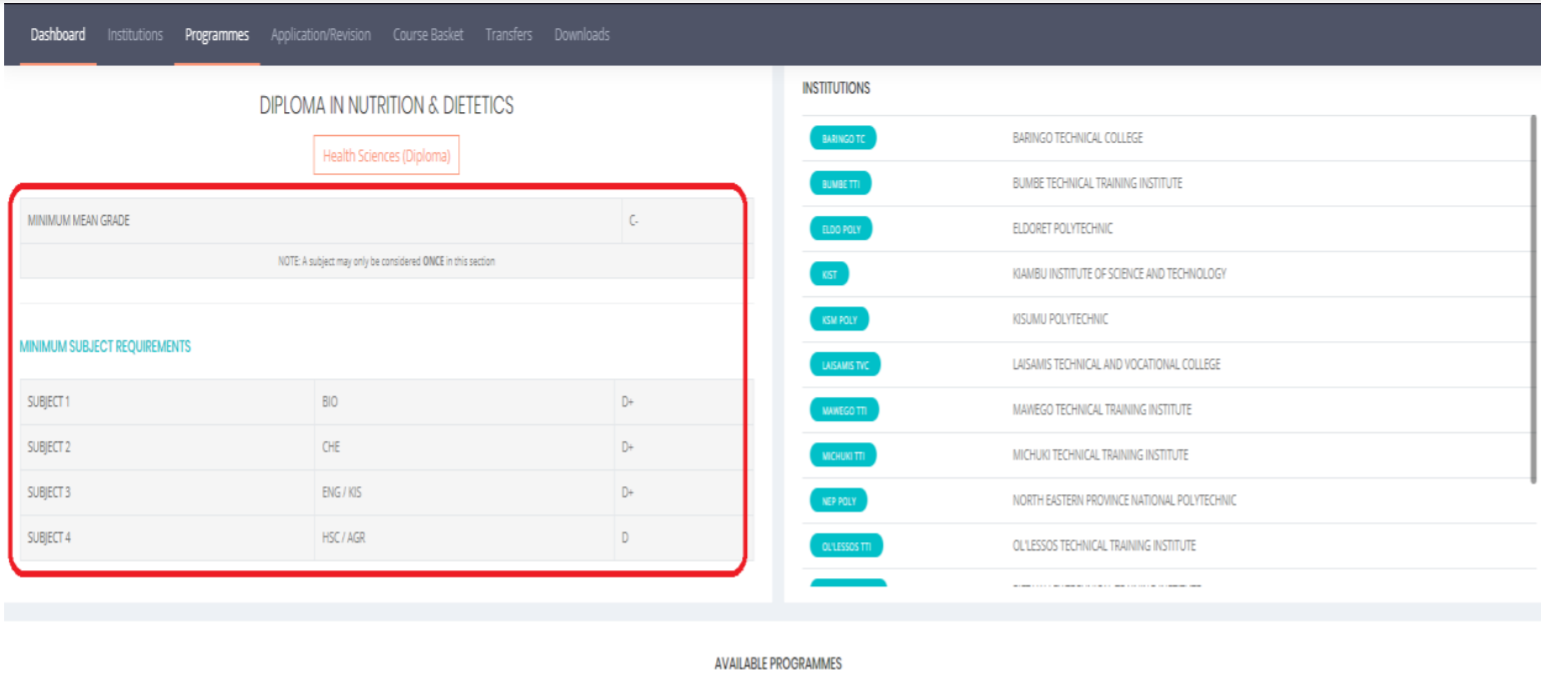
4. Once the applicant identifies a programme they feel they will compete favourably:
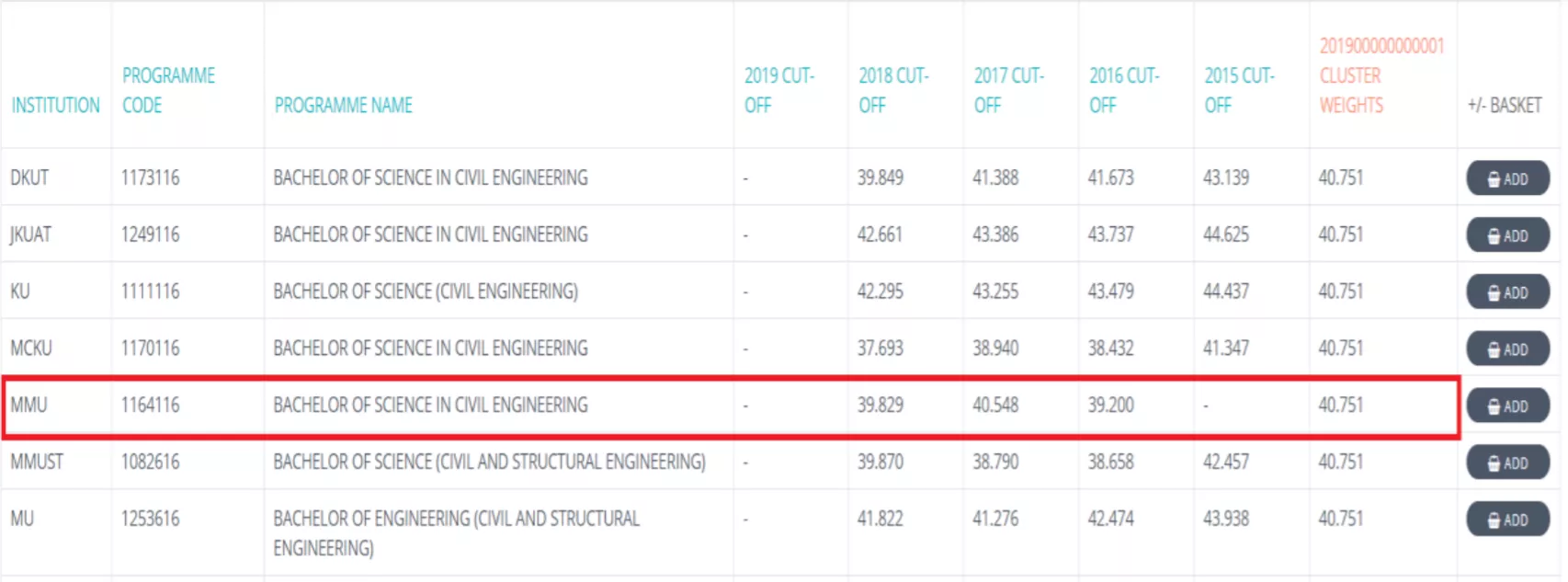
a. Only the 7-character code is needed for application:

5. You can write the code down for application later or add the programme to your course basket by clicking the button marked “ADD” next to the course.

a. For programmes added to the basket the button turns green and the words change to “ADDED”

b. The saved courses can be accessed by either clicking the menu item marked “Course Basket” or on the icon marked “Basket”
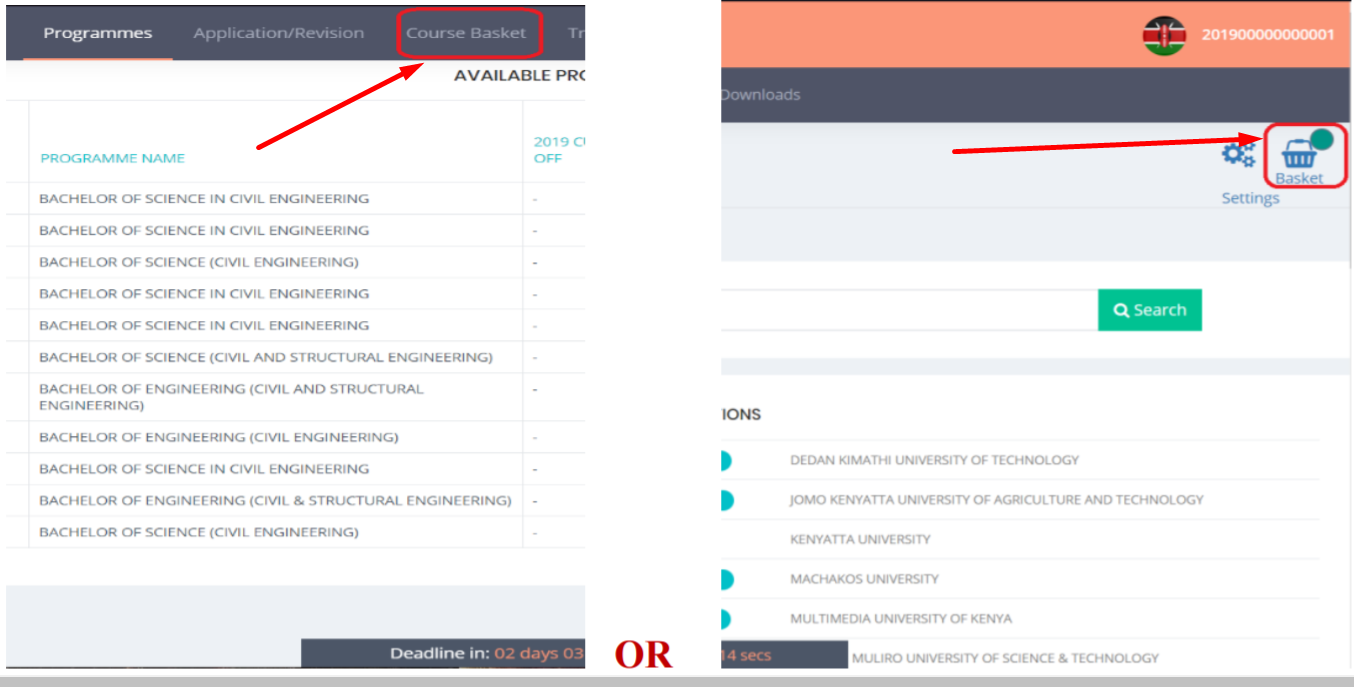
6. To view your saved courses, you must provide your contact information. a. Ensure the contacts are valid and correct as they will be used to get in touch with you after placement.
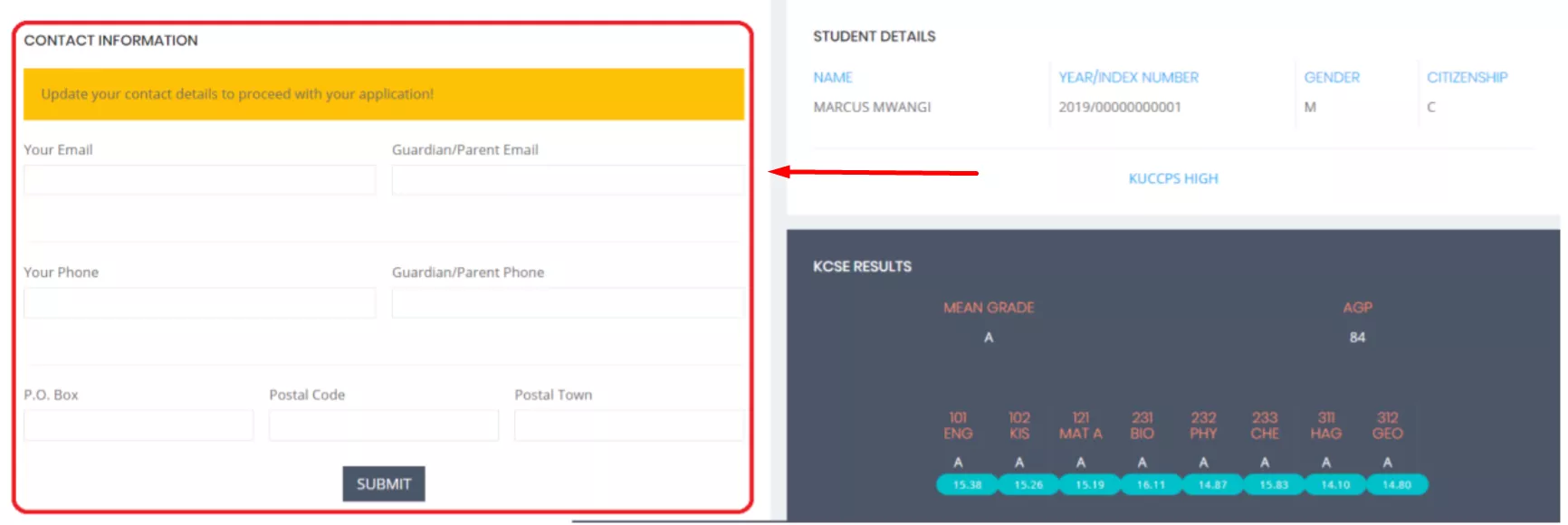
7. Only the courses shortlisted will be displayed here.

Alert:
This DOES NOT constitute an application, no course listed here will be considered until an application is made!
Step Ten: Making an Application
1. When you are ready to make an application, click on the tab titled; “Application/Revision”
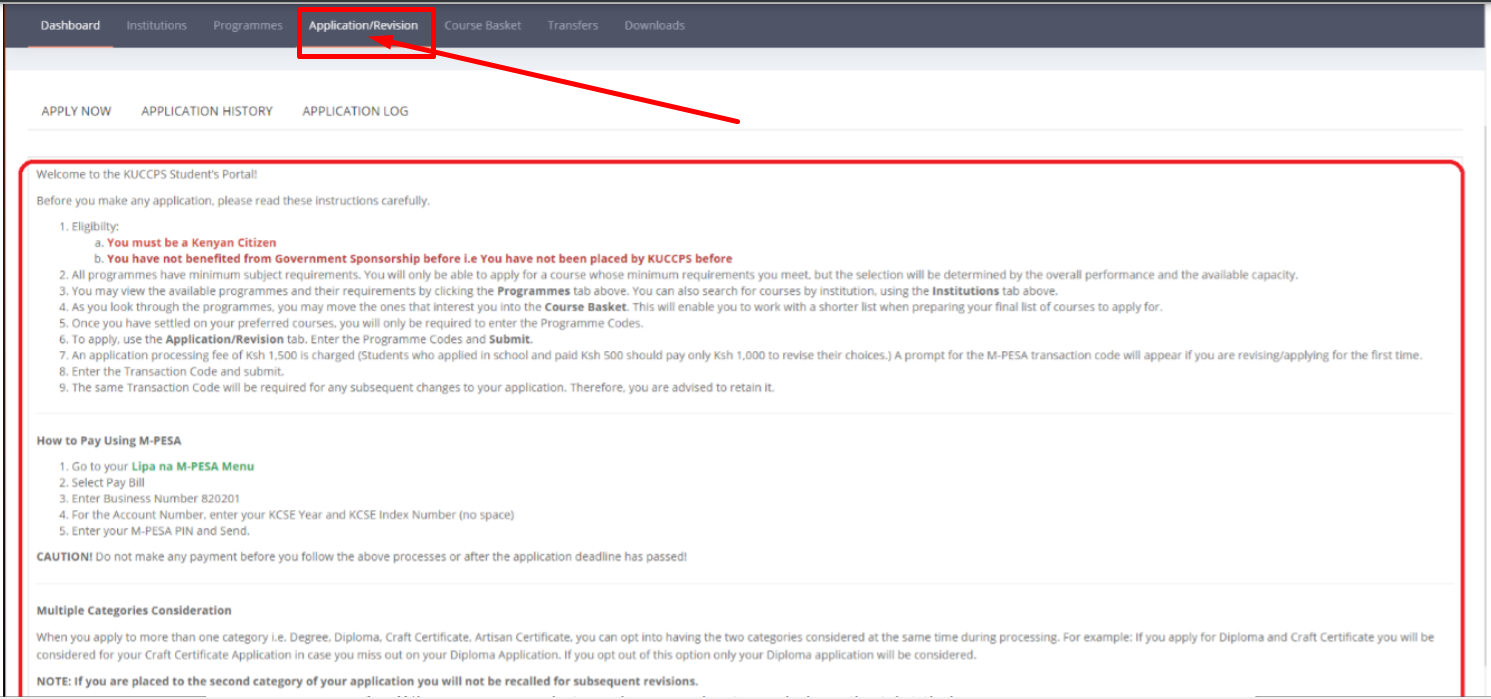
a. The application instructions will be listed here, read and understand.
2. Click on “APPLY NOW” to proceed

3. The applicant will see have access to a form (or two) for the level of programmes they qualify for:
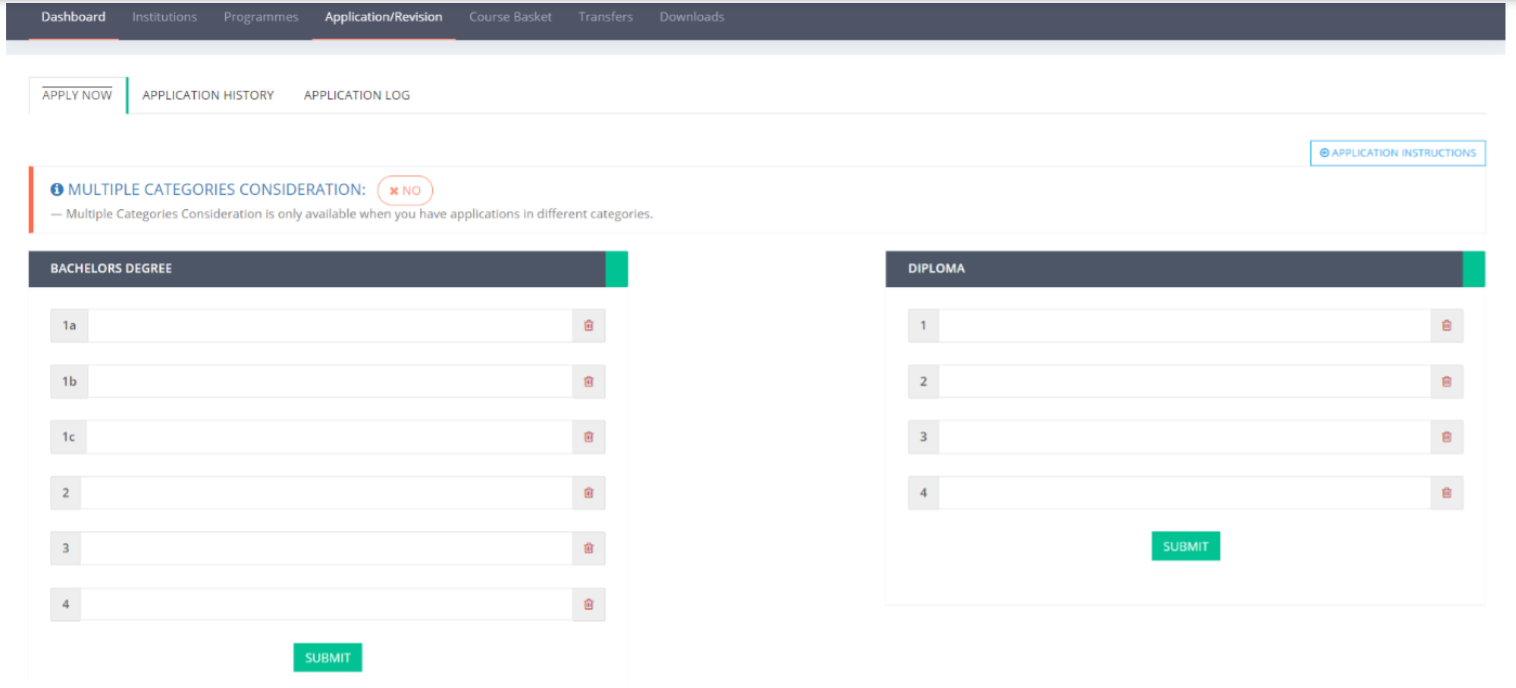
4. Enter the 7-character programme codes for the programmes that the applicant most prefers.
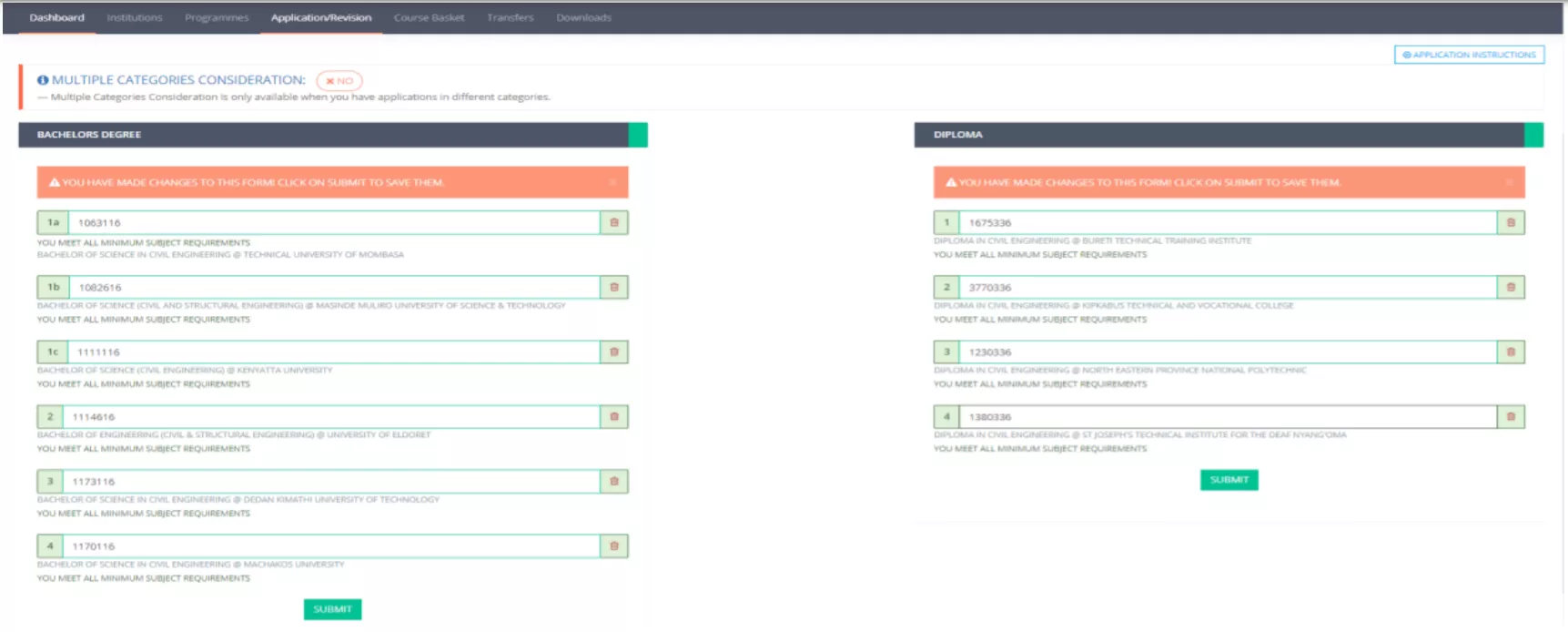
Tip: Placement processing follows the applicant’s list procedurally, so order them by order of preference i.e. most preferred as 1a and least preferred as 4.
a. Submit the application for consideration.

b. Make a payment through Mpesa with the details provided at this step.

Alert:
Do NOT make a payment before getting to this stage, the amount and account are unique to each applicant.
Tip:
i. Check the transaction code carefully not to confuse the numbers: ‘0’, ‘1’ and ‘5’ with the letters: ‘O’, ‘I’ and ‘S’.
ii. Retain the Mpesa message, you will need the transaction code every time you make changes.
10-0: Payment Reversals
Reversals will be done for erroneous payments in the following ways:
i. For non-existent accounts, reversals will be made within 14 days.
ii. Reversals for payments made to wrong but valid accounts e.g. payment made for account 12345678912 instead of 12345678911 must be requested in writing to the Chief Executive Officer.
10-1: Multiple Categories Applications
1. The applicant is allowed to apply for more that one level of programmes if they qualify for multiple i.e.: Diploma and Craft Certificate programmes.
a. You will need to click the “SUBMIT” button at the bottom of the form for the second level.

b. The applicant must explicitly opt-in to multiple category processing if the applicant wants the second level to be considered. The status is shown via a switch on the top of the page:
Note:

The programmes for the second level will not be considered unless the applicant opts in.
c. Opt-in

Alert:
This means if you miss your first set of applications, you will be considered for the second i.e. you may be placed to one of the Craft courses if you miss all your diploma choices.
10-2: Changing Application
An applicant may make as many changes as they want before the deadline. These include:
1. Opting out of multiple application processing:

a. The applicant will need to enter their password to verify the change.

Deleting applications:
a. Clicking on the “DELETE” button over the application.
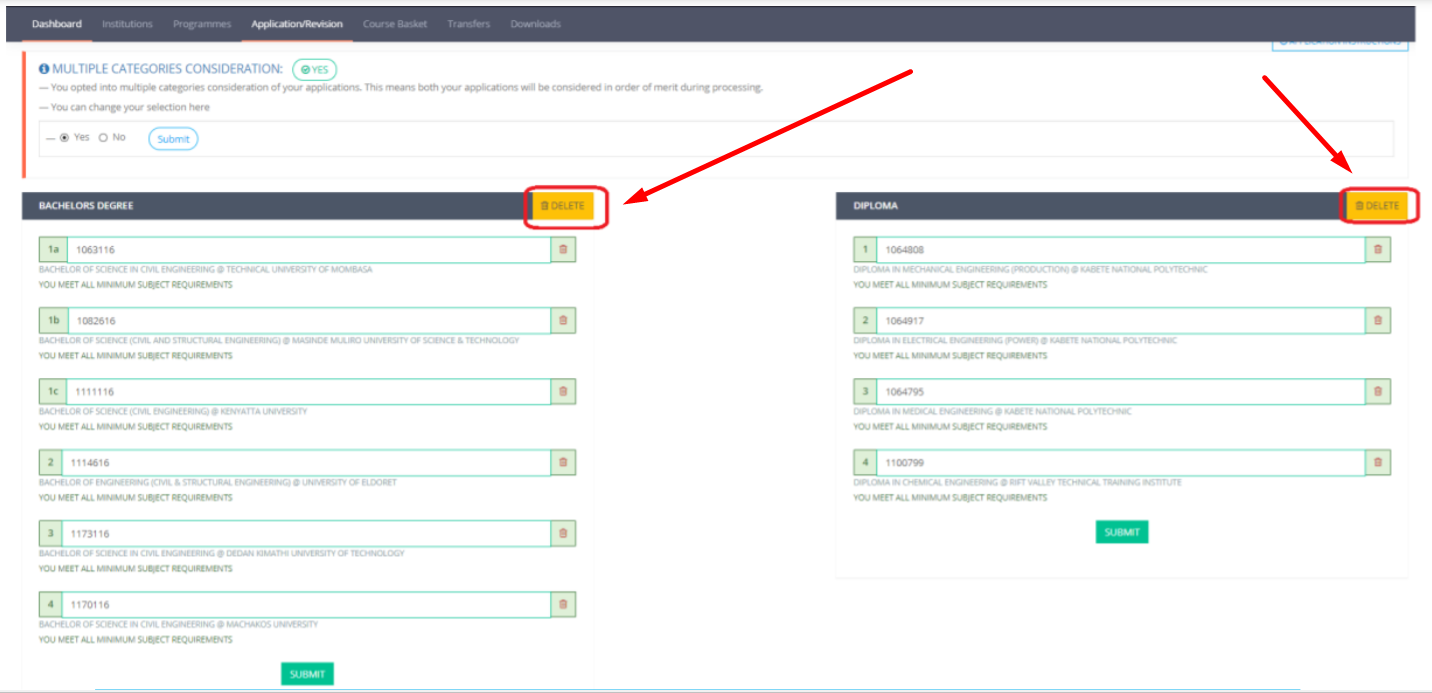
Alert:
This deletes the entire application and the choices.
b. Deleting every programme code one at a time.
10-3: Viewing Your Application
The applicant may view their application at any time by:
1. Visiting “Application/Revision” tab and moving to the “APPLICATION HISTORY” page:
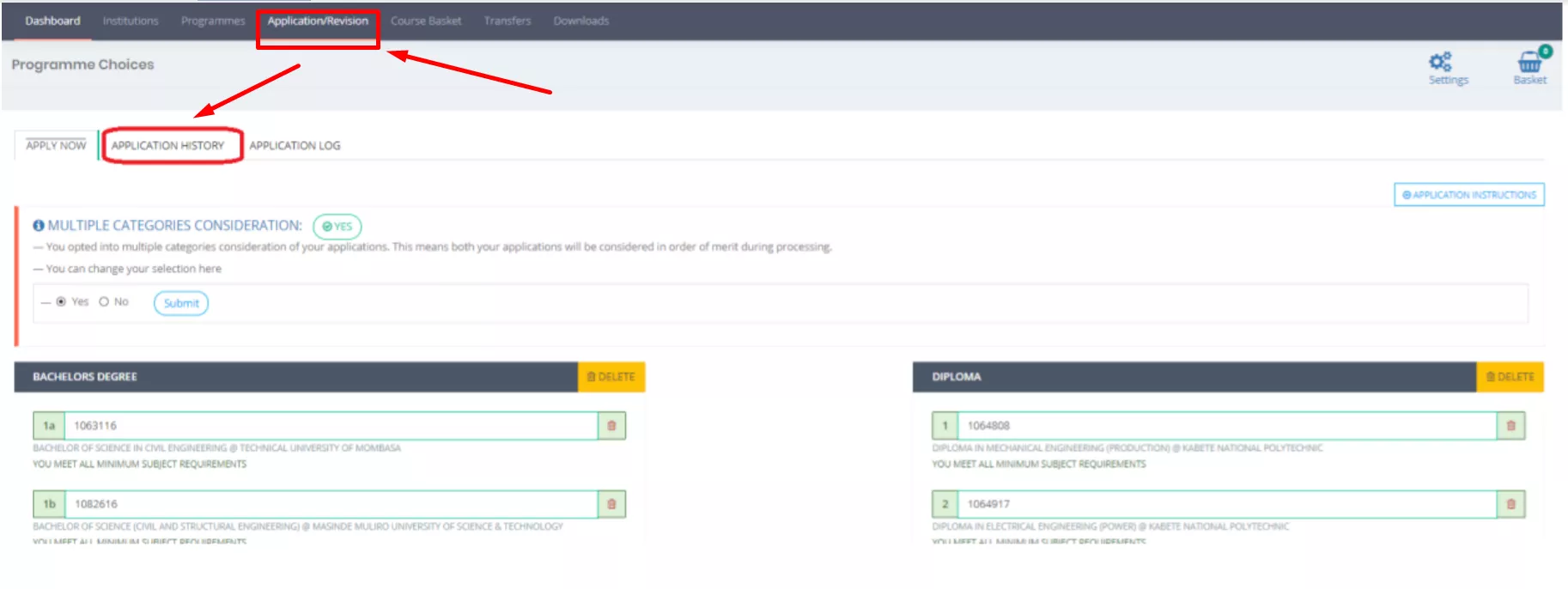
a. The current application will be viewable here, ensure the courses and their order are as you would want them considered.

2. Visiting “Dashboard” tab:
a. The active application will be highlighted in blue:
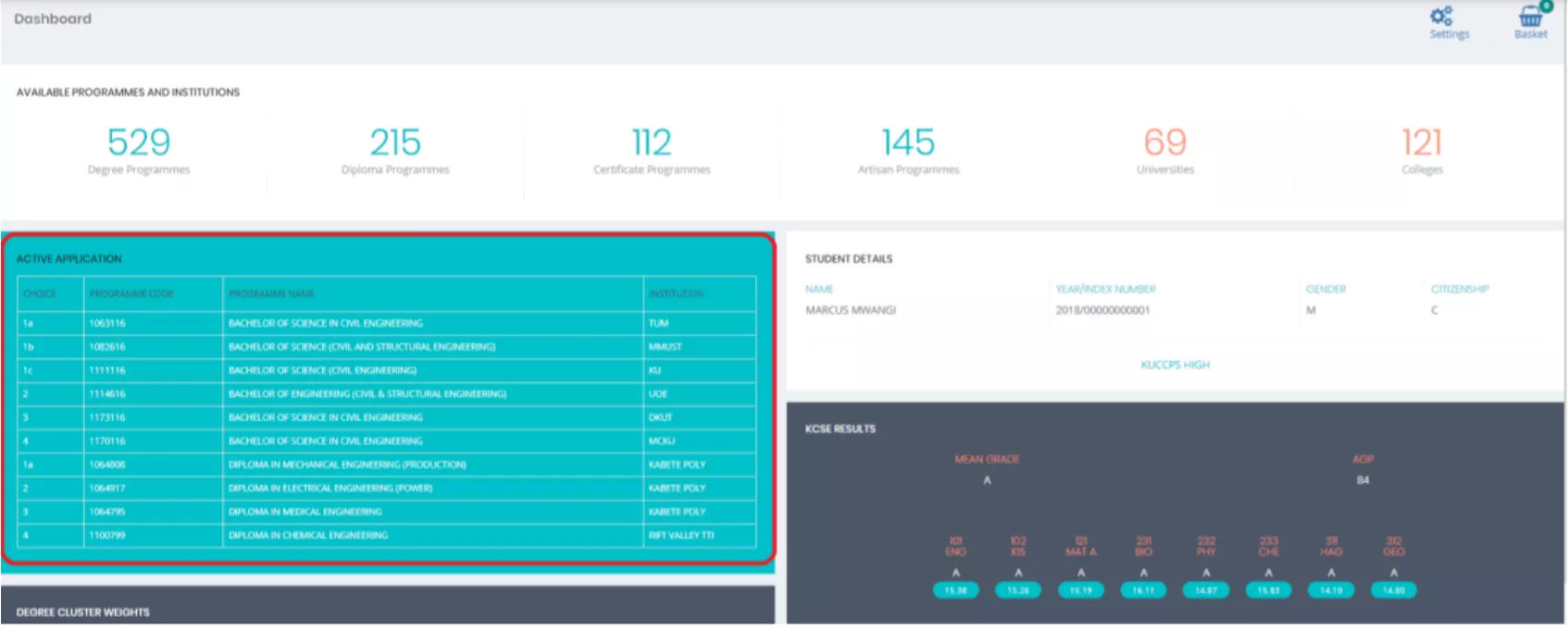
10-4: Tracking Your Application
3. The applicant can keep track of the changes made on the application by visiting “Application/Revision” tab and moving to the “APPLICATION LOG” page:

a. All changes made from the applicant’s account will be listed here
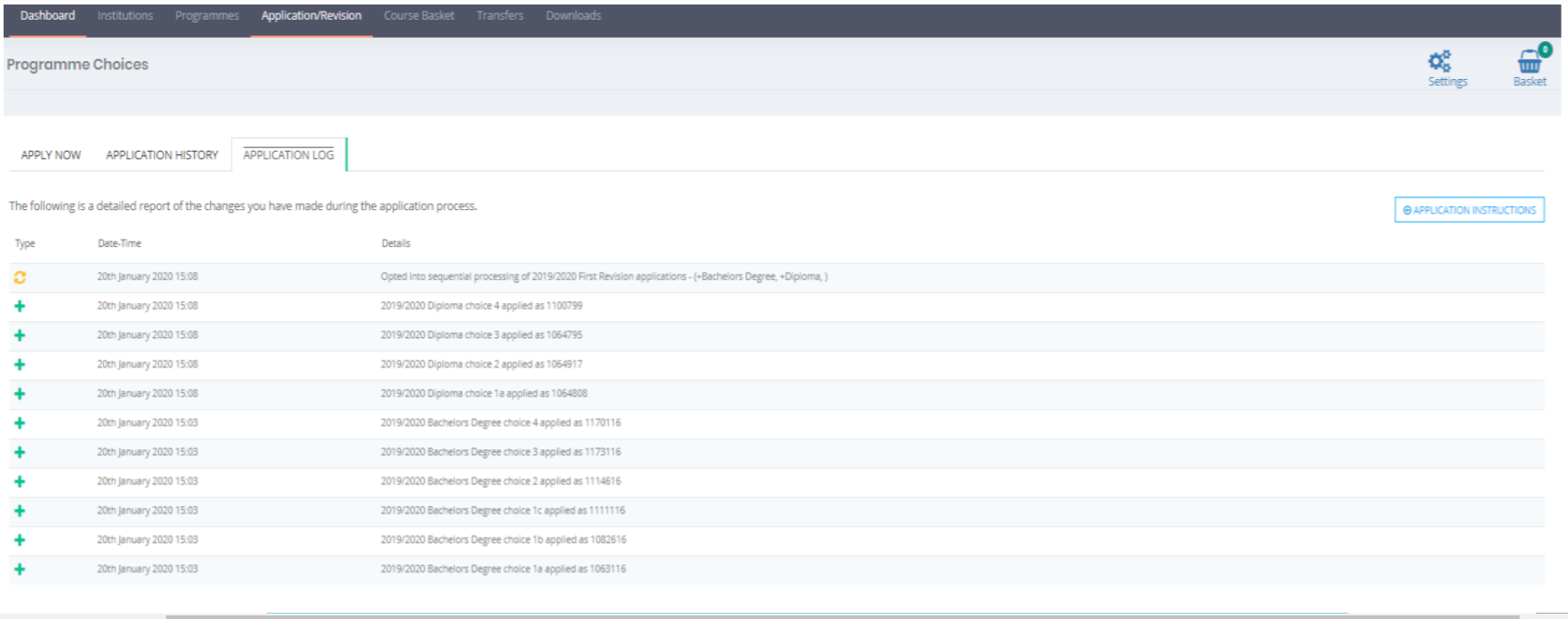
Settings
An applicant may change their contact information at any time by clicking the settings button:

The following form can then be edited:
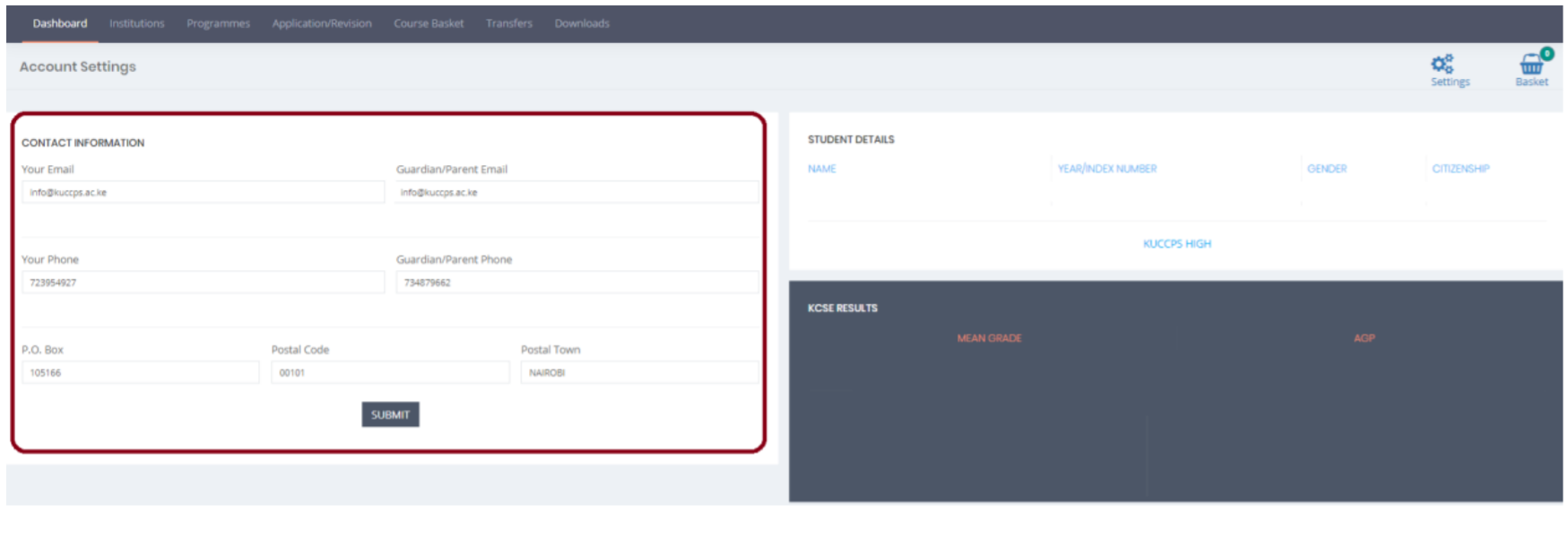
How to Know the University/College That You Have Been Placed by KUCCPS
KUCCPS admissions list is usually out shortly after the 2nd revision of courses.
To find out the university and course or the college and course you have been admitted to, log into your KUCCPS account and the details will be on the dashboard.
You will see an image similar to the one below indicating the university/college, course and code.
You will then get an sms and email from the university/college several days/weeks later.
More Tips & Resources;
- Be sure not to delete the Mpesa message once you have paid or record the details somewhere; you will need the transaction code every time you make changes. If you delete by mistake, you can get your Mpesa statement from Safaricom to retrieve the code.
- Pay the amount required at at a go. Do not split it e.g. 1000 then 500 or 500 then 500 again etc.
- Check and counter-check the numbers before submitting the payment. If you put your index number wrongly, it may take a while before there is a reversal of the Mpesa etc.
- Submit your application early. Do not wait until the last days.
- For university applicants, note that private universities may ask for higher fees than public universities, even for government sponsored students. Additionally, if you transfer to a different course from the one allocated by KUCCPS, you may be required to the same amount of fees paid by privately sponsored students.
